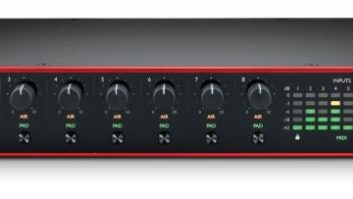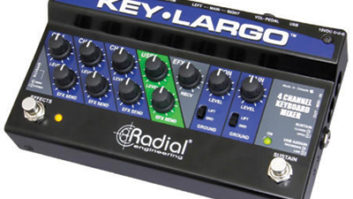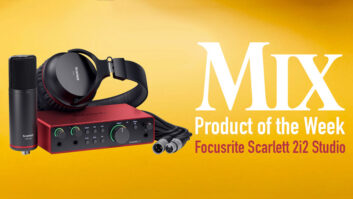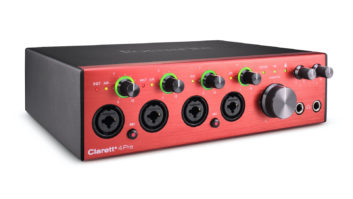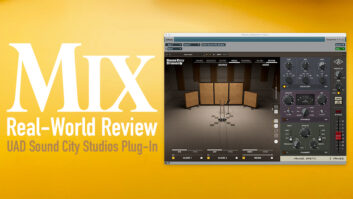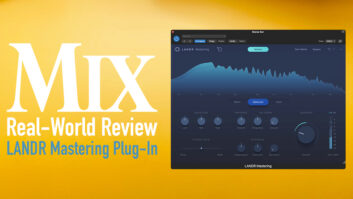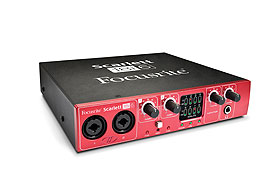
The Scarlett Suite comprises four plug-ins: gate (pictured), EQ, reverb and compressor.
Focusrite’s Scarlett plug-in suite is a set of professional processors selling at the decidedly non-professional price of $99. Available in boxed or downloadable versions, it comes in AU, RTAS and VST formats for both Mac and PC hosts (no TDM). Reminiscent of Focusrite’s ISA and Red Series hardware, Scarlett was developed by the Forte Suite designers.
Get More From Four
The Suite has four processors: an opto-based compressor/limiter; a cross-linked dual-mono/stereo gate; a 6-band Red 2 and ISA-inspired EQ with filters, two parametric midrange and high/low-shelving EQs; and a reverb that uses a classic studio reverb algorithm. All four plug-ins have input and output level controls — helpful for dealing with over-recorded “red” levels — but there are no individual in/out buttons on the EQ for checking the effect of each of the EQ’s six sections.
Once the suite was into my Pro Tools HD3 Accel rig on a Mac PPC quad-core running OS 10.4.11, I started with the Scarlett compressor and found it especially smooth on bass guitar. Just 2 or 3 dB of compression at 3:1 ratio, 2ms attack time and a 1-second release brought dynamic steadiness to a jumpy performance. Two large VU meters accurately reflect the compressor’s action, although gain reduction is measured upward — opposite to most gain-reduction meters.
On electric guitars, I loved the sound of the factory Tight Limiter preset for dynamically shaping a pushy eighth-note rhythm guitar part to fit better in the song. I used both Scarlett EQ and compressor on the lead vocal — a good combo because after rolling out mic proximity with the EQ’s Shelf section and brightening with the high-mid sections, the overall sound got thin. But following it with the Scarlett compressor warmed and fattened it back up nicely.
On electric guitars, I used the low-shelf EQ for clearing out speaker “chuffing” — low midrange mud — and then pushed the upper midrange for articulation with both the low-mid and high-mid parametric settings.

Select summary to visit site.
The Scarlett gate has the same metering as the compressor, and controls for attack, hold, release, threshold and range. Sidechaining is covered by a set of mode choices. Default mode is for a normal mono or stereo noise gate; Left 1 mode allows input 1 to control the gating of input 2 while you hear only input 2; Left 2 mode is identical but monitors both channels; mode Right 1 lets input 2 control input 1 while you hear only input 1; and Right 2 is the same but you hear both inputs.
I tried an old disco trick by routing the drum machine kick-drum track to bus 1 and the bass guitar track to bus 2. I set up a stereo aux fader (whose input was bus 1 and 2) and inserted the stereo Scarlett gate. Scarlett caused the kick to trigger the bass. This worked great because the machine kick-drum pattern was strictly on time, fast and busy while the bass player played legato. The producer loved that the bass guitar track only passed audio whenever the kick drum hit.
The Scarlett reverb is handy for inserting on individual tracks or for adding more reverb to another reverb. When setting this up and dialing in the reverb parameters, advance the wet/dry to wet to first understand the nature of the reverb. You’ll hear the built-in pre-delay and how the Size, Pre-Filter and Air parameters affect the reverb’s sound. This is a present-sounding reverb that worked well in good amounts for electric guitars and keyboards, and in smaller amounts on vocals.
When instantiating the reverb on single tracks, you’ll get a mono reverb — an old-school reverb in which the track and reverb become a unified sound, a localized point source. When I used it as a send/return stereo reverb, it sounded big and realistic. I liked the shorter settings for adding subtle ambience and coloration to rhythmic guitars or percussion instruments.
Undeniably Suite
The Scarlett Suite is a tremendous value, offering the Focusrite sound for less than $100. The only downside was the lack of individual bypass switching on the EQ. Other than that, I found all four plug-ins to be useful problem solvers.
